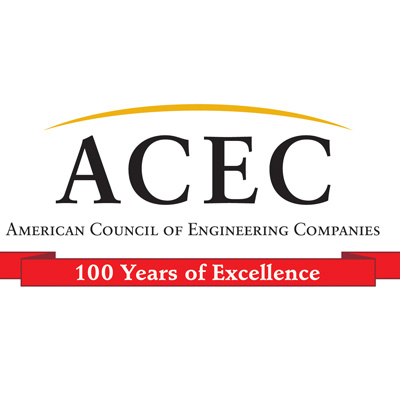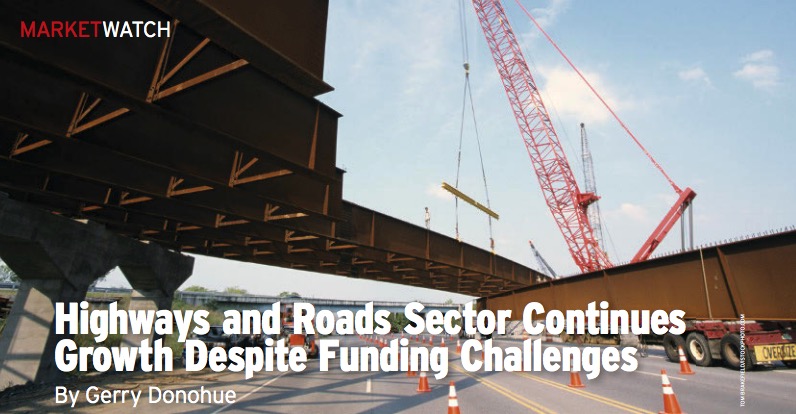AMERICAN COUNCIL OF ENGINEERING COMPANIES (ACEC)
Written by Gerry Donohue, ACEC’s senior communications writer
Funding for the nation’s highways and roads may be woefully insufficient, but for the engineering firms operating in the sector, funding has been steady and strong—and may improve.
“Over the past three years, the market has been in growth mode,” says Malcolm Dougherty, senior vice president and national transportation practice lead for Michael Baker International. “Last year, the pace picked up significantly, and we expect the current pace and trajectory to continue.”
States Filling the Void
According to FMI Corporation, noted industry management consultants, the highways and roads sector will grow at an average annual rate of about 2.2 percent over the next five years. The bulk of that growth will be in 2018 and 2019, with annual rates of 3 percent, before tailing off to just 1 percent by 2022.
Historically, growth in highways and roads has been due to the federal Highway Trust Fund. Using revenue from the federal fuel tax, the Highway Trust Fund finances most federal government spending for highways and mass transit through grants to state and local governments.
Although the federal government accounts for only about one-quarter of all public spending on roads and highways—with the remaining three quarters financed by state and local governments—these funds have acted as the accelerator for the system.
In recent years, due to the long-term failure to raise the gas tax, the Highway Trust Fund has been unable to bring in enough revenue to meet its obligations and has required frequent cash infusions from the federal government’s General Fund.
The Trump administration has proposed a new infrastructure financing program that would operate parallel to the Highway Trust Fund, using $200 billion in federal funds to stimulate $800 billion in private investment. Initially highly touted, the program has receded into the background and is not expected to resurface in 2018.
For engineering firms in the field, the infrastructure funding shortfall is noteworthy and demands a long-term sustainable solution, but the sector has adapted to the funding realities.
“We hear a lot of discussion from D.C. about the Trust Fund being insolvent, but much of that is overstated,” says Rich Markwith, market sector leader for the states and municipalities sector of TranSystems Corp. “The truth of the matter is that federal funding is stable through 2020. A lot of states and localities have taken steps over the past few years to address their own funding needs.”
More than half of states have increased their investment in highways and roads over the past few years. For example in 2017, California, Indiana, Montana, Oregon, South Carolina, Tennessee and West Virginia raised their gas taxes, and Utah adjusted its gas tax formula to raise more money. Additionally, Maine has a pending transportation bond measure, and West Virginia has approved a transportation bonding measure. Furthermore, Colorado, Idaho, New Hampshire and Wyoming have taken various steps to increase revenues for transportation.
In 2018, more than a dozen states are expected to consider measures to increase transportation funding. Furthermore, numerous cities and counties have taken it upon themselves to raise funds to build or repair local transportation and transit systems.
There has also been a limited influx of private money into the market. “In Silicon Valley, for example, two private companies have committed to spend up to $50 million to fund infrastructure improvements,” says Dougherty. “It is not going to be a significant part, but it is a part.”
Market Opportunities
Inside the transportation sector, firms are concentrating on the markets that offer the most potential. At TranSystems, that means tracking which states, counties and cities have been the most aggressive in raising transportation funds.
“Virginia, Georgia and Texas have been good strong markets,” says Markwith. “Just last year, California passed Senate Bill 1, providing another $5 billion a year for transportation. Florida has done a fantastic job of having multiple streams of revenue for transportation.”
John Barton, DOT market sector leader and senior vice president for HNTB Corp., says alternative delivery systems have expanded the market for engineering firms.
“Design-build and construction-manager-at-risk contracts are creative solutions that we can offer to public clients that have constrained resources, both in funding and people,” says Barton. “Public-private partnerships are a bit of an opportunity, but not as much as the others.”
HNTB has also increased its focus on specific segments of the transportation sector, such as transit, passenger rail and toll roads. “Tolling has had a bit of an uptick recently, getting some federal support, both for traditional toll roads and price-managed lanes,” says Barton.
Solving the Funding Problem
In the next few years, firm leaders expect to see continued investment by the states but also a solution to the flat-lining of federal funding.
“There is recognition of how much of our infrastructure is coming of age and needs to be repaired and refreshed,” Dougherty says. “We expect the federal government to be a robust partner.”
Barton agrees. “We are going to see a renaissance for these programs,” he says. “We will not see this devolving to the funding coming only from the state level. There will be a strong federal component.”
Where the federal funds will come from is less certain. The federal gas tax has not been increased since 1993, and Congress appears to have no resolve to take on the issue.
“It is surprising there is such resistance at the federal level to raising the gas tax because we see it all over the place at the state level, and there appears to be little backlash,” says Markwith. “We have tried to identify people who have lost seats by voting for the gas tax, and it appears to be 5 percent or less of them.”
“Going forward,” Markwith adds, “the only method that has anything behind it is some sort of mileage-based system.”
Intelligent Transportation
One of the most promising trends in the transportation sector is the advent of intelligent transportation systems. HNTB, Michael Baker International and TranSystems are investing money and staff in the field.
“We have a very strong internal practice, with several dozen experts in the field,” says Barton. “It is a growing practice within the industry and HNTB.”
It is also a multifaceted practice, with a wide range of potential clients, from helping the auto manufacturers deliver the communications components to working with public entities on the infrastructure.
“States and cities are looking for expertise on what they should expect,” says Dougherty. “Many states are leading the charge— California and Michigan are two examples.”
Some of the technology is already reaching the market. Several luxury car brands offer adaptive or dynamic cruise control that changes a vehicle’s speed based on the cars around it. The more complicated concepts—connected or even autonomous cars—are farther off.
“It is going to be a little slower than we read about,” says Markwith. “The technologies are not the issue. They are easier than the institutional and individual behavioral challenges, such as getting people to accept riding in a driverless car.”
Download full article (PDF): Highways and Roads Sector Continues Growth Despite Funding Challenges
Download full September/October issue of Engineering, Inc.
 About the American Council of Engineering Companies
About the American Council of Engineering Companies
www.acec.org
The American Council of Engineering Companies (ACEC) is the voice of America’s engineering industry. Council members – numbering more than 5,000 firms representing more than 500,000 employees throughout the country – are engaged in a wide range of engineering works that propel the nation’s economy, and enhance and safeguard America’s quality of life. These works allow Americans to drink clean water, enjoy a healthy life, take advantage of new technologies, and travel safely and efficiently. The Council’s mission is to contribute to America’s prosperity and welfare by advancing the business interests of member firms.
Tags: ACEC, American Council of Engineering Companies, Engineering Inc., Highways and Roads Sector







 RSS Feed
RSS Feed